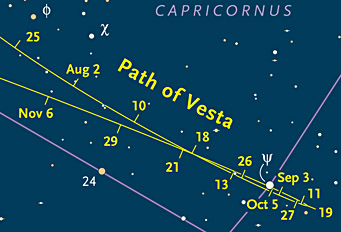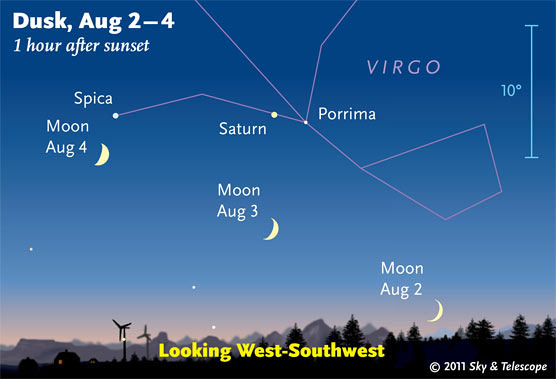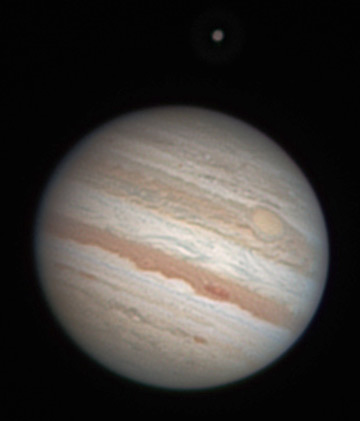Friday, July 29
Saturday, July 30

The tick marks show Vesta's location at 0:00 Universal Time on the dates indicated. It's moving toward the lower right in August. This is a narrow closeup; click for our larger, printable finder charts for Ceres and Vesta for 2011.
Sky & Telescope diagram
Sunday, July 31
Monday, August 1
Tuesday, August 2

The waxing Moon reappears at dusk this week below Saturn and Spica. (These scenes are drawn for the middle of North America. European observers: move each Moon symbol a quarter of the way toward the one for the previous date. The Moon is shown three times its actual apparent size. The blue 10° scale is about the size of your fist held at arm's length.)
Sky & Telescope diagram
Wednesday, August 3
Thursday, August 4
Friday, August 5
Saturday, August 6
Want to become a better amateur astronomer? Learn your way around the constellations. They're the key to locating everything fainter and deeper to hunt with binoculars or a telescope.
For an easy-to-use constellation guide covering the whole evening sky, use the big monthly map in the center of each issue of Sky & Telescope, the essential magazine of astronomy. Or download our free Getting Started in Astronomy booklet (which only has bimonthly maps).
Sky Atlas 2000.0 (the color Deluxe Edition is shown here) plots 81,312 stars to magnitude 8.5. That includes most of the stars that you can see in a good finderscope, and typically one or two stars that will fall within a 50× telescope's field of view wherever you point. About 2,700 deep-sky objects to hunt are plotted among the stars.
Alan MacRobert
Once you get a telescope, to put it to good use you must have a detailed, large-scale sky atlas (set of charts). The standards are the Pocket Sky Atlas, which shows stars to magnitude 7.6; the larger Sky Atlas 2000.0 (stars to magnitude 8.5); and the even larger and deeper Uranometria 2000.0 (stars to magnitude 9.75). And read how to use sky charts effectively.
You'll also want a good deep-sky guidebook, such as Sky Atlas 2000.0 Companion by Strong and Sinnott, or the more detailed and descriptive Night Sky Observer's Guide by Kepple and Sanner, or the classic if dated Burnham's Celestial Handbook.
Can a computerized telescope take their place? I don't think so — not for beginners, anyway, and especially not on mounts that are less than top-quality mechanically. As Terence Dickinson and Alan Dyer say in their Backyard Astronomer's Guide, "A full appreciation of the universe cannot come without developing the skills to find things in the sky and understanding how the sky works. This knowledge comes only by spending time under the stars with star maps in hand."
This Week's Planet Roundup
Mercury and Venus are hidden in the glare of the Sun.
Mars (magnitude +1.4, crossing from Taurus into Gemini) glows dim and distant low in the east-northeast before and during dawn. It's lower right of Capella and lower left of Aldebaran. In a telescope, Mars is just a tiny blob only 4.4 arcseconds in diameter. It's on its way to a poor opposition (13.9 arcseconds wide) next March.

Jupiter on the morning of July 31st, with Callisto passing south of it, imaged by S&T's Sean Walker. The South Equatorial Belt (above center) remains wide, and the great Red Spot lacks its usual light Red Spot Hollow. The North Equatorial Belt remains narrow and darker red-brown. Walker used a 12.5-inch Newtonian telescope and an Imaging Source video camera to create this stacked-frame image.
S&T: Sean Walker
Jupiter (magnitude –2.4, in southern Aries) rises in the east around midnight daylight saving time. Look above it for the little star pattern of Aries and (once Jupiter is well up) closer below it for the head of Cetus, rather dim. By dawn Jupiter shines very high in the southeast.
Saturn (magnitude +0.9, in Virgo) is sinking ever lower in the west-southwest at dusk. Look 12° left of it for Spica and 2° right or lower right of it for fainter Gamma Virginis (Porrima).
Uranus (magnitude 5.8, in western Pisces) and Neptune (magnitude 7.8, in western Aquarius) are well up in the east or southeast after midnight. Here's our printable finder chart for both.
Pluto (magnitude 14.0, in northern Sagittarius) is highest in the south soon after dark. A big finder chart for it is in the July Sky & Telescope, page 64.
All descriptions that relate to your horizon — including the words up, down, right, and left — are written for the world's mid-northern latitudes. Descriptions that also depend on longitude (mainly Moon positions) are for North America. Eastern Daylight Time (EDT) equals Universal Time (also known as UT, UTC, or GMT) minus 4 hours.
To be sure to get the current Sky at a Glance, bookmark this URL:
http://SkyandTelescope.com/observing/ataglance?1=1
If pictures fail to load, refresh the page. If they still fail to load, change the 1 at the end of the URL to any other character and try again.
 0
0
Comments
You must be logged in to post a comment.